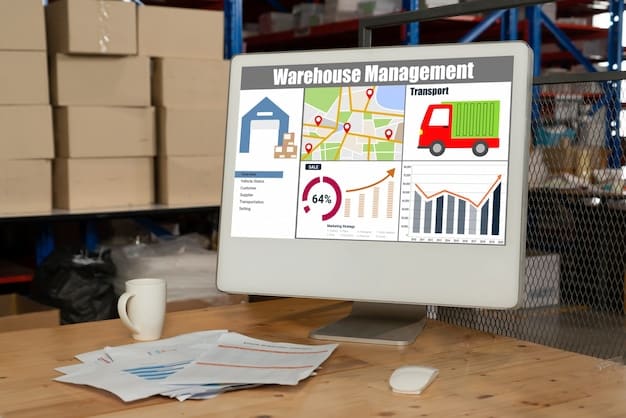E-commerce Platform Integrations: 5 Essential APIs for US Order Fulfillment in 2025

E-commerce platform integrations are crucial for automating order fulfillment, and in 2025, 5 essential APIs—inventory management, order management, shipping & tracking, payment processing, and customer relationship management will streamline operations for US e-commerce businesses.
In the rapidly evolving world of e-commerce, efficient order fulfillment is paramount, and e-commerce platform integrations: 5 essential APIs to automate your US order fulfillment in 2025, are likely to be the key to staying competitive. How can these integrations revolutionize your business and provide a seamless experience for your customers?
The Importance of API Integrations for E-commerce
Application Programming Interfaces (APIs) act as the digital glue connecting different software systems. For e-commerce, this means linking your online store with vital services to automate and streamline workflows, enhancing efficiency and customer satisfaction.
In 2025, the e-commerce landscape will be even more competitive, demanding seamless operations. API integrations become not just an advantage, but a necessity. But why are they so important?
Improved Efficiency and Automation
Manual processes are time-consuming and prone to errors. API integrations automate tasks such as inventory updates, order processing, and shipping notifications, freeing up your team to focus on strategic initiatives. This translates to faster order fulfillment and reduced operational costs.
Enhanced Customer Experience
Customers expect real-time updates and seamless interactions. API integrations enable features such as accurate order tracking, personalized recommendations, and streamlined checkout processes. A smooth customer journey increases satisfaction and drives repeat business.
- Automated inventory updates across all sales channels.
- Real-time order tracking for customers.
- Personalized product recommendations based on purchase history.
- Streamlined and secure checkout processes.
Effective API integrations can significantly enhance key performance indicators, leading to improved profitability and customer loyalty. Ignoring these advancements can leave businesses struggling to keep pace in the competitive market.

Inventory Management API
Maintaining accurate inventory levels is crucial for avoiding stockouts and overselling. An inventory management API automates the synchronization of product quantities across all sales channels, including your online store, marketplaces, and brick-and-mortar locations.
By integrating your e-commerce platform with an inventory management system, you can ensure that your customers always see accurate product availability, reducing the risk of disappointing them with out-of-stock items. How does this API work?
Real-Time Inventory Updates
The API automatically updates inventory levels whenever a product is sold or received. This eliminates the need for manual adjustments and ensures that your inventory data is always up-to-date. Real-time accuracy minimizes errors and improves operational efficiency.
Integration with Multiple Channels
Whether you sell on your website, Amazon, eBay, or in a physical store, the inventory management API centralizes your inventory data. This comprehensive view enables you to make informed decisions about restocking and promotions, maximizing your sales potential.
- Preventing overselling by accurately reflecting product availability.
- Reducing the risk of stockouts by providing alerts when inventory levels are low.
- Improving order fulfillment speed by ensuring products are readily available.
- Optimizing inventory levels to minimize storage costs.
Implementing an inventory management API provides a competitive edge and enhances the customer experience by ensuring accurate product availability and faster order fulfillment. Embracing this integration is essential for sustainable growth.
Order Management API
Efficient order management is the backbone of successful e-commerce operations. An order management API automates the processing of orders from placement to fulfillment, reducing manual effort and minimizing errors.
This API connects your e-commerce platform with your order management system, enabling seamless communication and real-time updates on order status. But what capabilities does this integration unlock?
Automated Order Processing
The API automatically captures order details, such as customer information, product selections, and shipping addresses, and transfers them to your order management system. This eliminates the need for manual data entry and reduces the risk of errors. Automation accelerates the order lifecycle, improving customer satisfaction.
Real-Time Order Tracking
Customers can track their orders in real-time, from the moment they place the order to the time it is delivered. The order management API provides the necessary data for accurate tracking notifications, keeping customers informed and reducing inquiries.

| Key Point | Brief Description |
|---|---|
| 📦 Inventory API | Automates inventory tracking across all sales channels |
| 🚚 Shipping API | Streamlines shipping with label generation & real-time tracking. |
| 💰 Payment API | Enables secure, diverse payment options for customers. |
| 🫂 CRM API | Enhances customer relationships through data-driven interactions. |
Frequently Asked Questions
▼
An API (Application Programming Interface) allows different software systems to communicate and share data with each other automatically. In e-commerce, APIs enable integrations between your store and other services, such as payment gateways or shipping providers.
▼
In 2025, the e-commerce market will be even more competitive. API integrations are crucial for automating processes, enhancing customer experience, and improving overall efficiency, helping US businesses stay competitive.
▼
An inventory management API automates the synchronization of product quantities across all sales channels, reducing the risk of overselling or stockouts. This leads to improved customer satisfaction and operational efficiency.
▼
Key features include automated shipping label generation and real-time tracking updates for customers. The API integrates with shipping carriers, providing accurate tracking information and streamlining the shipping process.
▼
A CRM API integrates your e-commerce platform with your CRM system, centralizing customer data. This enables personalized marketing efforts, improved customer service, and targeted communication, enhancing customer loyalty.
Conclusion
Embracing these five essential API integrations—inventory management, order management, shipping & tracking, payment processing, and CRM—will best position US e-commerce businesses for success in 2025. Automating these processes not only drives efficiency but also elevates customer satisfaction, providing a competitive edge in the dynamic e-commerce landscape.





